1. Įvadas
Flanšinis drugelio vožtuvas (FBV) yra ketvirčio apsisukimo vožtuvas, plačiai žinomas kaip aukšto slėgio ir nuolatinių skysčių valdymo sistemų darbinis arkliukas.
Pasižymi integruotais flanšais, pritvirtintais tiesiai prie vamzdyno flanšų, jie suteikia a kietas, sandarus, ir struktūriškai stabilus ryšys,
svarbus pranašumas prieš plokštelinius vožtuvus (taupantis erdvę, bet tinkamas žemo slėgio darbams) ir antgalio tipo vožtuvai (vidutinio slėgio, dažnai už nekritines paslaugas).
Sukurta vidutinio ir didelio skersmens vamzdynai, flanšiniai peteliški vožtuvai derinami griežtas uždarymas, konstrukcijos patikimumas, ir priežiūra.
Tuo pačiu metu, dėl jų universalumo jie yra būtini Vandens valymas, ŠVOK tinklai, ir bendras pramoninis perdirbimas, kur jų Kompaktiškas dizainas, ekonomiškumo, ir prisitaikymas prie slėgio ir temperatūros intervalų suteikti ilgalaikę eksploatacinę vertę.
2. Kas yra flanšinis drugelio vožtuvas?
Pagrindinė apibrėžtis ir veikimo principas
A flanšinis drugelio vožtuvas (FBV) yra a ketvirčio apsisukimo sukamasis vožtuvas skirtas srautui vamzdynuose reguliuoti arba izoliuoti.
Jo išskirtinis bruožas yra integruoti flanšai, kuris prisukamas tiesiai prie vamzdžių flanšų (pagal ANSI B16.5 arba ISO 7005), sukurti a kietas, sandarus, ir nuolatinis ryšys tinka aukšto slėgio tarnybai.
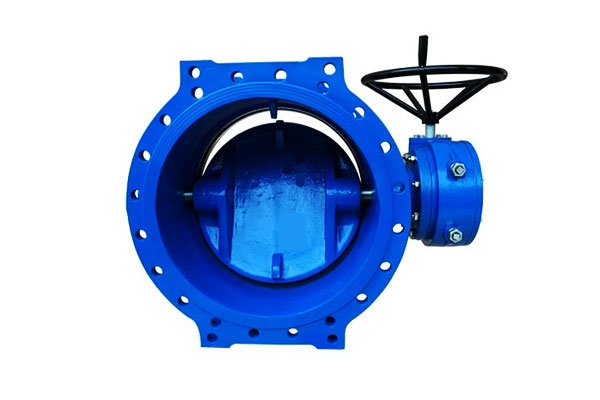
Vožtuvas veikia paprastu principu:
- Visiškai atidaryta (0°): Diskas yra lygiagrečiai tekėjimui, sumažinti slėgio nuostolius (paprastai 1–3 psi 6 colių vožtuvui esant vardiniam srautui).
- Droselis (10–80°): Dalinis sukimasis riboja srautą; Ekscentriniai diskai suteikia daugiau linijinio srauto valdymo nei koncentriniai tipai.
- Visiškai uždaryta (90°): Diskas tvirtai prispaudžiamas prie sėdynės, pasiekti tvirtą uždarymą. FBV yra dvikryptis, efektyviai valdyti srautus pirmyn ir atgal.
Flanšinio drugelio vožtuvo anatomija
Flanšinis drugelio vožtuvas yra sukurtas ilgaamžiškumas ir tikslumas valdymas, paprastai susideda iš šešių pagrindinių komponentų:
| Komponentas | Dizaino savybės | Pagrindinis vaidmuo |
| Kūnas (su flanšais) | Lietas/kaltas su integruotais flanšais; varžtų skylės susilygina su vamzdyno flanšais. | Užtikrina slėgio ribą ir nuolatinį montavimą. |
| Diskas | Apvali plokštelė (plokščias arba ekscentrinis profilis). | Sukasi, kad atidarytų / uždarytų arba droselio srautas. |
| Kamienas (Velenas) | Tvirtas strypas, užsandarintas sandarinimo žiedais. | Perduoda sukimo momentą iš pavaros į diską. |
| Sėdynė | Atsparus (EPDM/PTFE) arba metalo (Stellite, SS). | Užtikrina sandarų sandarumą nuo disko. |
| Flanšo tarpiklis | Suspaudžiama sandarinimo medžiaga tarp flanšų. | Apsaugo nuo išorinio nuotėkio. |
| Pavara | Vadovas, elektrinis, pneumatinis, arba hidraulinis. | Suteikia ketvirčio apsisukimo valdymą izoliacijai arba moduliacijai. |
Flanšinis vs. Vaflė vs. Lug drugelio vožtuvai
The integruotas flanšo dizainas išskiria FBV nuo plokštelių ir auselių tipų, siūlo unikalius pranašumus didelės paklausos programoms:
| Savybė | Flanšinis drugelio vožtuvas | Vaflinis drugelio vožtuvas | LUG Butterfly vožtuvas |
| Montavimas | Prisukamas per integruotus flanšus | Suspaustas tarp flanšų | Prisukamas per sriegines korpuso kilpas |
| Slėgio įvertinimas | ANSI 150–900 (28– 210 barų) | ANSI 150–300 (28– 70 barų) | ANSI 150–600 (28-140 barų) |
| Svoris (6-coliai, SS) | ~12 kg | ~5,6 kg | ~8 kg |
| Dujotiekio išmontavimas | Reikia atsukti flanšus | Reikia nuimti flanšo porą | Galimas tik vožtuvo pašalinimas |
| Santykinė kaina | Aukštesnis (1.5×) | Žemiau (0.7×) | Vidutinis (1.0×) |
| Geriausias skirtas | Aukšto slėgio, nuolatinė tarnyba (aliejus, dujos, garas, Chemikalai) | Žemas slėgis, kompaktiškos sistemos | Vidutinio slėgio, lankstūs priežiūros poreikiai |
3. Dizaino variacijos: Koncentrinis vs. Ekscentriniai flanšiniai drugelio vožtuvai
Flanšiniai peteliški vožtuvai pirmiausia klasifikuojami pagal disko ir stiebo išlygiavimas, kritinis veiksnys, turintis įtakos slėgio įvertinimas, sandarinimo efektyvumas, sukimo momento reikalavimai, ir programos tinkamumas.
Koncentriniai flanšiniai drugelio vožtuvai (Standartinis dizainas)
Geometrija: Disko ir koto ašys sutampa su vožtuvo angos centru, darant dizainą koncentrinis. Eksploatacijos metu, sėdynė palaiko kontaktą per visą disko paviršių.
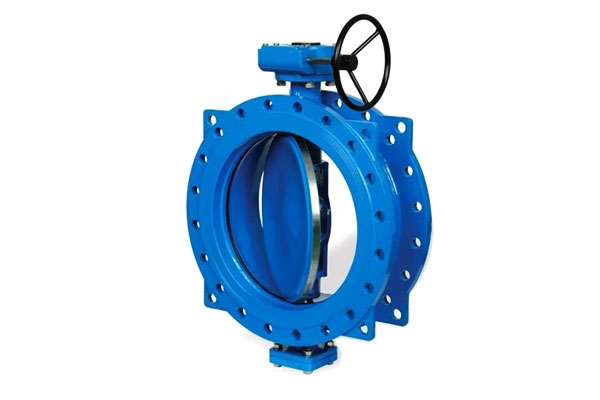
Našumo metrika:
- Slėgio įvertinimas: ANSI klasė 150–300 (28–70 barų 20°C temperatūroje)
- Nuotėkio klasė: API 609 IV klasė (≤0,01% vardinio srauto skysčiams)
- Sukimo momento reikalavimas: 60–100 N·m (6-colių vožtuvas, EPDM sėdynė)
- Ciklo gyvenimas: 10,000– 20 000 ciklų (elastinga sėdynė riboja tarnavimo laiką)
Privalumai:
- Paprasta, ekonomiškas dizainas
- Lengva priežiūra ir sėdynės keitimas
- Tinka vidutinės temperatūros ir slėgio skysčiams
Apribojimai:
- Didelė disko sėdynės trintis sumažina efektyvumą
- Netinka dujų tiekimui ar aukšto slėgio įrenginiams
- Ribotas patvarumas veikiant abrazyviniams arba aukštos temperatūros skysčiams
Tipiškos programos:
- ŠVOK šalto vandens sistemos
- Komunalinio vandens paskirstymas
- Žemas slėgis, nekritinės pramonės paslaugos
Ekscentriniai flanšiniai drugelio vožtuvai (Didelio našumo dizainas)
Apžvalga: Ekscentriški dizainai kompensuoti diską arba kotą, sumažina disko ir sėdynės trintį ir pagerina sandarinimo efektyvumą.
Šie dizainai idealiai tinka aukšto slėgio, aukšta temperatūra, ir dujų programos.
Vienvietis ekscentrikas (Offsetinis diskas) Flanšinis drugelio vožtuvas
Dizainas: Disko centras yra nukrypęs nuo koto ašies, kuris sumažina sąlytį su sėdyne sukimosi metu, mažinant trintį.
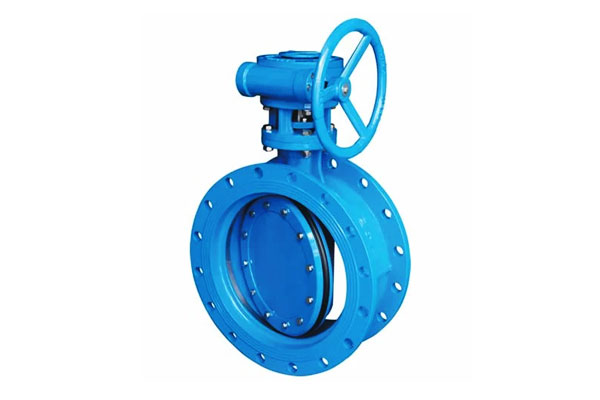
Našumo metrika:
- Slėgio įvertinimas: ANSI klasė 300–600 (70-140 barų)
- Nuotėkio klasė: API 609 V klasė (≤0,001% vardinio srauto)
- Sukimo momento reikalavimas: 40–70 N·m (6-colių vožtuvas, PTFE sėdynė)-~30% mažesnis nei koncentriniai vožtuvai
Paraiškos:
- Pramoninis vandens valymas
- Žemo slėgio alyvos linijos
- Programos, kurioms reikalingas vidutinis srauto valdymas ir geresnis efektyvumas
Dvigubas ekscentrikas (Offsetinis diskas + Kamienas) Flanšinis drugelio vožtuvas
Dizainas: Tiek disko centras, tiek koto ašis yra nutolusios nuo angos centro. Tai pašalina disko lizdo kontaktą iki 80–85% uždarymo, žymiai sumažina trintį ir susidėvėjimą.

Našumo metrika:
- Slėgio įvertinimas: ANSI klasė 600 (140 baras 20°C temperatūroje); iki klasės 900 su metalinėmis sėdynėmis
- Nuotėkio klasė: API 609 VI klasė (≤0,00001% vardinio srauto) - tinkamas dujų servisui, įskaitant gamtinių dujų vamzdynus
- Temperatūros diapazonas: -29°C iki 482 °C (metalinės sėdynės)
Paraiškos:
- Cheminis apdorojimas
- Aliejus & dujotiekiai
- Garų sistemos
- Aukšto slėgio pramoniniai skysčiai, kuriuos reikia sandariai uždaryti
Trigubas ekscentriškas (Užskaita + Kūginis diskas) Flanšinis drugelio vožtuvas
Dizainas: Prideda a trečiasis poslinkis įvedant kūginę / kūginę disko geometriją, pasiekti a metalas-metalinis sandariklis nereikia elastinės sėdynės.
Ši konstrukcija leidžia dirbti esant ekstremalioms temperatūroms ir slėgiui.

Našumo metrika:
- Slėgio įvertinimas: ANSI klasė 900 (210 baras 20°C temperatūroje)
- Temperatūros diapazonas: -29°C iki 650 °C (Stellite® arba kietmetalinės sėdynės)
- Ciklo gyvenimas: 50,000– 100 000 ciklų (metalinės sėdynės ilgaamžiškumas)
Paraiškos:
- Hipergarsinės transporto priemonių aušinimo sistemos
- Elektrinės perkaitinto garo linijos
- Rafinavimo kataliziniai krekeriai ir naftos chemijos perdirbimas
- Ekstremali pramoninė aplinka, kuriai reikalingas nulinis nuotėkis ir ilgas tarnavimo laikas
Santrauka:
| Savybė | Koncentrinis | Vienvietis ekscentrikas | Dvigubas ekscentrikas | Trigubas ekscentriškas |
| Disko ir koto išlygiavimas | Centrinė linija | Disko poslinkis | Diskas + stiebo poslinkis | Diskas + kamienas + kūginis poslinkis |
| Slėgio įvertinimas | 28– 70 barų | 70-140 barų | 140– 210 barų | 210 Baras |
| Nuotėkio klasė | IV | V | VI | VI (metalas) |
| Sukimo momento reikalavimas | Vidutinis | Žemesnis nei koncentrinis | Aukštesnis | Aukštas (reikia pavaros) |
| Temperatūros diapazonas | - | Vidutinis | -29°C iki 482 °C | -29°C iki 650 °C |
| Tipiškas naudojimas | Žemo slėgio vanduo/ŠVOK | Vidutinio stiprumo pramoniniai skysčiai | Aukšto slėgio skysčiai/dujos | Ekstremalios pramonės/naftos chemijos |
4. Medžiagos & Flanšinio drugelio vožtuvo sandarikliai
Spektaklis, patikimumas, ir dvigubų flanšinių drugelių vožtuvų ilgaamžiškumas (FBV) yra stipriai veikiami Medžiagos pasirinkimas kūnui, diskas, kamienas, ir sandarinimo elementai.
Tinkamos medžiagos užtikrina suderinamumą su skysčiu, atsparumas korozijai, aukšto slėgio valdymas, ir tinkamas ekstremalioms temperatūroms.
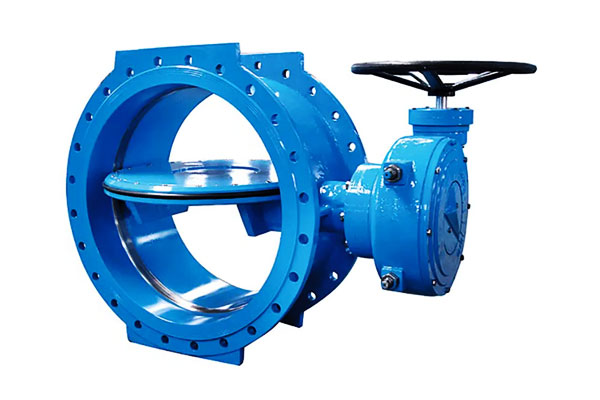
Kūno medžiagos
Vožtuvo korpusas yra pagrindinė slėgio riba ir turi atlaikyti mechaninis įtempis, vidinis slėgis, ir aplinkos korozija. Įprastos kūno medžiagos apima:
| Medžiaga | Savybės | Tipiškos programos |
| Anglies plienas (A216 WCB) | Didelė jėga, vidutinio atsparumo korozijai, ekonomiškai efektyvus | Vanduo, garas, mažai ėsdinančios cheminės medžiagos |
| Nerūdijantis plienas (316/316L, A351 CF8M) | Puikus atsparumas korozijai, Higiena, vidutinis atsparumas aukštai temperatūrai | Cheminis apdorojimas, maistas & gėrimas, Jūrų aplinka |
| Kariuomenė geležis (EN-GJS-400-15, ASTM A536) | Gera jėga, ekonomiškai efektyvus, padengtas atsparus korozijai | Vandens paskirstymas, nuotekų, ŠVOK |
| Lydinio plienas (Hastelloy C276, Duplex 2205) | Aukščiausias atsparumas chemikalams ir temperatūrai | Naftos chemija, rūgštys, agresyvūs pramoniniai skysčiai |
Disko medžiagos
Diskas yra tiesiogiai veikiamas srauto ir dažnai rankenos Abrazyvinis, erozinis, arba korozinius skysčius. Pasirinkimas grindžiamas Mechaninis stiprumas, atsparumas korozijai, ir sandarinimo suderinamumas:
- 316 Nerūdijantis plienas: Plačiai naudojamas bendrosios paskirties cheminėms medžiagoms, vanduo, ir garo programos.
- Hastelloy C276: Atsparus oksiduojančioms ir redukuojančioms cheminėms medžiagoms; tinka agresyvioms rūgštims.
- Kalusis ketus su PTFE danga: Maža trintis, atsparus korozijai vandeniui ir švelnioms cheminėms medžiagoms.
- Stellite®-Plakti diskai: Aukštos temperatūros ir didelio susidėvėjimo pritaikymas, įskaitant perkaitintus garus ir naftos chemiją.
Dizaino pastaba: Diskas gali būti koncentrinis, ekscentriškas, arba trigubas poslinkis, su metaline arba elastine danga, kad pagerintų sandarumą ir sumažintų susidėvėjimą.
Stiebo medžiagos
Kotas perduoda sukimo momentą iš pavaros arba rankinio rato į diską ir yra veikiamas mechaninis įtempis, spaudimas, ir skysčių kontaktas. Įprastos medžiagos:
| Medžiaga | Savybės | Paraiškos |
| 416 Nerūdijantis plienas | Didelė jėga, Geras atsparumas korozijai, ekonomiškai efektyvus | Vanduo, ŠVOK, bendroji pramonė |
| 316/316L Nerūdijantis plienas | Puikus atsparumas korozijai, vidutinis atsparumas aukštai temperatūrai | Cheminė, Jūrų, maistas & gėrimas |
| Hastelloy C276 / Dvipusis plienas | Ypatingas atsparumas korozijai ir temperatūrai | Agresyvios cheminės medžiagos, aukšto slėgio naftos chemijos |
Sėdynės medžiagos ir sandariklių tipai
The sėdynė sudaro kritinę sandarinimo sąsają su disku, nuotėkio klasės nustatymas, sukimo momento reikalavimas, ir tarnavimo laikas. Pasirinkimas priklauso nuo skysčio tipas, spaudimas, ir temperatūra.
| Sėdynės tipas | Medžiaga | Nuotėkio klasė | Temperatūros diapazonas | Pastabos |
| Elastinga sėdynė | EPDM, NBR, FKM, Ptfe | API 609 IV–V klasė | -50°C iki 200 °C | Puikus sandarinimas skysčiams; mažas sukimo momentas; ne aukštos temperatūros garams |
| Metalinė sėdynė | Nerūdijantis plienas, Stellite® | API 609 VI klasė | -29°C iki 650 °C | Didelis patvarumas; tinka dujoms, aukšto slėgio, ir aukštos temperatūros programos |
| PTFE pamušalas | Grynas PTFE arba užpildytas PTFE | API 609 V klasė | -50°C iki 200 °C | Atsparus chemikalams; maža trintis; gali šliaužti esant aukštam slėgiui |
| Elastomeras + Metalo hibridas | EPDM / metalas arba PTFE / metalas | API 609 V–VI klasės | -29°C iki 482 °C | Sujungia sandarumą ir atsparumą dilimui; paplitusi dvigubo ekscentrinio dizaino |
Tarpinės ir pavaros sąsajos
- Flanšo tarpinės: Grafitas, Ptfe, arba nitrilinės tarpinės užtikrina sandarios flanšinės jungtys tarp vožtuvo ir vamzdyno.
- Pavaros sandarikliai: O žiedai arba PTFE įvorės neleidžia skysčio nutekėjimas išilgai stiebo tuo pačiu užtikrinant sklandų sukimo momento perdavimą.
5. Gamyba & Flanšinių vožtuvų liejimo metodai
Gamyba iš flanšiniai peteliški vožtuvai (FBV) reikalauja didelio tikslumo, tvirtos medžiagos, ir griežtas tarptautinių standartų, tokių kaip API, laikymasis 609, ISO 5752, ir ANSI B16.5.
Vožtuvai, sukurti aukšto slėgio ir didelio našumo reikmėms, pavyzdžiui, alyvai & dujotiekiai, Cheminiai augalai, ir elektros energijos gamyba – turi eksponuoti matmenų tikslumas, Struktūrinis vientisumas, ir sandarus veikimas.
Butterfly vožtuvo komponentų liejimas
Liejimas yra pagrindinis vožtuvų korpusų ir diskų formavimo būdas, leidžia sukurti sudėtingas geometrijas ir ekonomiškai efektyvią gamybą. Dideliems vožtuvams (paprastai baigiasi 12 coliai), Smėlio liejimas yra plačiai naudojamas.
Šiame procese, išlydytas metalas (1450–1550°C) pilamas į derva surištas smėlio formas.
Smėlio liejimas leidžia nukrypti nuo ±0,5 mm, todėl tinka anglinio plieno arba kaliojo ketaus vožtuvams, naudojamiems komunalinio vandens ar žemo slėgio pramoniniuose vamzdynuose.
Mažiems ir vidutiniams vožtuvams (2– 12 colių) reikalaujantis didelio matmenų tikslumo ir atsparumo korozijai, Investicijų liejimas (prarastas vaško metodas) yra įdarbintas. Vaško raštai padengti keraminiais apvalkalais, išsilydo, ir pakeistas išlydytu metalu.
Šiuo metodu pasiekiamos griežtos tolerancijos (±0.1 mm) ir lygūs paviršiai, įgalinamos tikslios funkcijos, pvz., dvigubi ekscentriniai diskų stebulės.
Investicinis liejinys idealiai tinka 316L nerūdijančiam plienui, Hastelloy, arba kitų korozijai atsparių lydinių.
Kalimas: Didelio stiprumo komponentai
Kalimas yra tinkamiausias būdas kritiškas, aukšto slėgio komponentai tokių kaip kūnai, flanšai, ir stiebai, nes sukuria geresnę grūdėtumo struktūrą ir didesnį tempimo stiprumą.
Šildomas metalas (1100–1200°C) formuojamas po hidrauliniais presais arba štampais, todėl dalys yra 20–30 % tvirtesnės nei lygiaverčiai liejiniai.
Kaltiniai komponentai paprastai naudojami ANSI klasėje 600 arba aukštesni alyvos vožtuvai & dujotiekiai, elektrinės, ir kiti reiklūs pramoniniai pritaikymai.
Kalimo metodai apima didelių nestandartinių dalių kalimą atviru štampu, Tikslių matmenų uždaro tipo kalimas vidutinio dydžio komponentams, ir sutrikdyti kalimą, siekiant sustiprinti svarbias sankryžas, tokias kaip disko stebulės.
Apdirbimas: Tiksli apdaila
Po liejimo ar kalimo, CNC apdirbimas užtikrina aukštą matmenų tikslumą, paviršiaus apdaila, ir tinkamas derinimas:
- Flanšo paviršiai yra sumalti, kad viduje būtų lygumas 0.1 mm ir varžtų skylių išlyginimas pagal ANSI B16.5 standartus, užtikrinant nesandarias jungtis.
- Sėdynės angos yra šlifuojami arba apdirbami iki Ra 1,6–3,2 μm, kad būtų galima tinkamai pritvirtinti sėdynę ir veiksmingai sandarinti.
- Diskai ir šakotuvai, ypač ekscentriško dizaino, yra baigti 5 ašių CNC frezavimu, kad būtų išlaikytas plokštumas 0.05 mm sandariam uždarymui.
- Stiebai ir guoliai yra tiksliai sukami ir frezuojami, kad būtų užtikrintas sklandus sukimasis ir teisingas sukimo momento perdavimas.
Terminis apdorojimas: Mechaninės ir korozijos savybės
Terminis apdorojimas pagerina stiprumą, kietumas, ir atsparumas korozijai, priklausomai nuo naudojamos medžiagos:
- Anglies plienas (WCB): Grūdinamas 850 °C temperatūroje ir grūdintas 650 °C temperatūroje, kad būtų pasiektas tempiamasis stipris ≥485 MPa.
- 316L Nerūdijantis plienas: Atkaitintas tirpalu 1050–1100 °C temperatūroje, po to aušinamas vandeniu, kad būtų atkurtas atsparumas korozijai ir homogenizuota mikrostruktūra.
- Duplex 2205: Atkaitintas tirpalu 1020–1080 °C temperatūroje, kad būtų pasiektas subalansuotas austenito ir ferito santykis (50:50), optimizuoti stiprumą ir atsparumą korozijai.
Paviršiaus apdorojimas: Ilgaamžiškumas & Atsparumas korozijai
Paviršiaus apdaila užtikrina ilgaamžiškumą atšiaurioje aplinkoje:
- Pasyvavimas 316L nerūdijančiam plienui sustiprina natūralų chromo oksido sluoksnį, pagerinti atsparumą korozijai iki 20%.
- Epoksidinės dangos 100–150 μm apsaugoti anglinio plieno korpusus alyvoje & dujotiekiai nuo grunto ir atmosferinės korozijos.
- Elektropolidavimas naudojamas sanitariniuose įrenginiuose (maistas, gėrimas, Farmacijos produktai) pasiekti Ra ≤0,8 μm, pašalina mikroskopinius plyšius ir bakterijų negyvas zonas.
Susirinkimas & Kokybės užtikrinimas
Po apdirbimo ir paviršiaus apdorojimo, vožtuvai surenkami ir atliekama griežta kokybės kontrolė:
- Sėdynės ir disko integracija: Sėdynės surištos arba presuojamos, ir ekscentriniai diskai yra kruopščiai sureguliuoti, kad būtų galima tiksliai išjungti.
- Stiebo montavimas: Guoliai, pakavimas, ir yra sumontuoti O žiedai, ir sukimo momentas patikrintas.
- Hidrostatinis arba pneumatinis bandymas: Patvirtina sandarumą esant projektiniam slėgiui.
- Neardomieji bandymai (Ndt): Tokie metodai kaip rentgeno spinduliai, ultragarsinis, arba dažų įsiskverbimo patikrinimai nustato vidinius defektus.
- Pavaros kalibravimas: Vadovas, elektrinis, pneumatinis, arba hidraulinės pavaros tikrinamos dėl sukimo momento ir eigos tikslumo.
6. Slėgio reitingai, Dydžiai & Standartai
Flanšiniai drugelio vožtuvai (FBV) yra sukurti taip, kad būtų patikimi esant įvairiems slėgiams, dydžiai, ir pramonės standartai.
Tinkamas pasirinkimas užtikrina saugumą, ilgalaikis veikimas, ir suderinamumas su vamzdynų sistemomis.
Slėgio reitingai
| Slėgio klasė | Maksimalus darbinis slėgis (20° C.) | Įprasta sėdynės medžiaga | Pastabos / Paraiškos |
| ANSI klasė 150 | 19 Baras | EPDM, Ptfe | Žemo slėgio vandens ir ŠVOK sistemos |
| ANSI klasė 300 | 51 Baras | EPDM, Ptfe | Komunalinė vanduo, žemo slėgio pramoniniai vamzdynai |
| ANSI klasė 600 | 102 Baras | Metalas, Sudėtinis | Aliejus & dujos, Cheminis apdorojimas |
| ANSI klasė 900 | 155 Baras | Metalas | Aukšto slėgio garas, naftos perdirbimo gamykla, ekstremalios temperatūros paslauga |
Standartiniai dydžiai
| Nominalus skersmuo (DN) | colio dydis | Tipiškos programos | Pastabos |
| DN 50–150 | 2–6 | Laboratorinės sistemos, ŠVOK, maži vandens vamzdynai | Kompaktiškas, lengva montuoti |
| 200–600 DN | 8–24 | Komunalinė vanduo, Cheminis apdorojimas, pramoniniai vamzdynai | Standartinis pramoninis asortimentas |
| 700–1200 DN | 28–48 | Didelio masto aliejus & dujos, Nuotekų valymas, elektrinės | Didelio srauto, aukšto slėgio tarnyba |
| DN 1400–2000+ | 56-80+ | Sunkioji pramonė, naftos perdirbimo gamyklos, hidroelektrinė | Dažnai reikalinga gamyba pagal užsakymą |
Akis į akį matmenys: Paprastai atitinka ISO 5752 Serija 10 arba API 609 dėl lengvo pakeičiamumo.
Pagrindiniai standartai & Sertifikatai
| Standartas / Sertifikavimas | Taikymo sritis | Paraiška / Aktualumas |
| API 609 | Dizainas & pramoninių drugelių vožtuvų bandymai | Bendrosios pramonės paslaugos |
| ISO 5752 | Akis į akį & flanšo matmenys | Užtikrina pakeičiamumą |
| ASME B16.34 | Metalinių vožtuvų slėgio ir temperatūros rodikliai | Struktūrinis vientisumas & saugumas |
| MSS SP-67 | Dydžio nustatymas & srauto koeficiento standartizavimas | Tikslus srauto valdymas |
| ASTM A216 / A351 | Anglies plienas & nerūdijančio plieno liejiniai | Medžiagų kokybė slėgio tarnybai |
| ASME B16.5 | Flanšo matmenys & varžtų modeliai | Suderinamumas su vamzdynais |
| API 598 / ISO 5208 | Lukštas & sėdynės sandarumo bandymas | Užtikrina sandarų veikimą |
| NACE MR0175 / ISO 15156 | Rūgščios alyvos atsparumas korozijai & dujų paslauga | Ilgalaikis patikimumas agresyvioje aplinkoje |
| PED 2014/68/ES | Slėginės įrangos atitiktis (Europa) | Teisinė & ES įrenginių saugos atitiktį |
7. Įjungimas & Valdymo sistemos
Flanšiniai drugelio vožtuvai yra ketvirčio apsisukimo prietaisai reikalingos pavaros, galinčios pasukti 90° kampu.
Pavaros pasirinkimas priklauso nuo vožtuvo dydžio, sukimo momento reikalavimas, skysčio tipas, ir valdymo sudėtingumą.
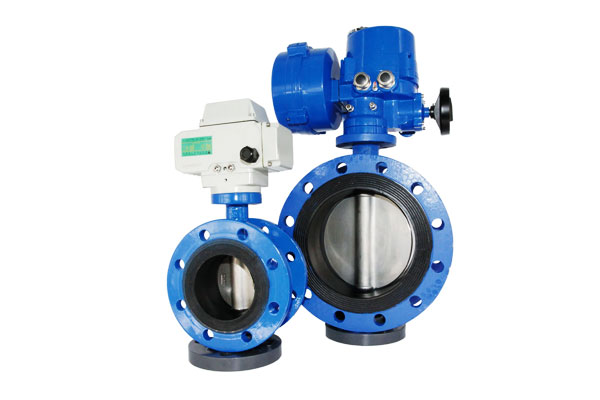
Įprasti pavarų tipai ir specifikacijos
| Pavaros tipas | Tipiškas vožtuvo dydis (Coliai) | Sukimo momento diapazonas (N·m) | Galia / Energijos šaltinis | Reagavimo laikas | Kontrolės galimybės | Saugi parinktis |
| Rankinis ratas | 2–6 | 10–50 | Žmogaus operacija | <5 s | Įjungta/Išjungta | N/A |
| Pavarų operatorius | 8–24 | 80–300 | Instrukcija su mechaniniais pranašumais | 30– 60 s | Įjungta/Išjungta | N/A |
| Elektrinė pavara | 2–36 | 50–1000 | AC 110/220V, DC 24V | 5– 30 s | Moduliavimas / įjungimas / išjungimas | Atsarginė baterija |
| Pneumatinė pavara | 2–36 | 50–500 | 6– 8 barų suslėgtas oras | 0.5– 5 s | Moduliavimas / įjungimas / išjungimas | Pavasario sugrįžimas |
| Hidraulinė pavara | 12–48 | 500– 2000 | 10-30 MPa hidraulinis skystis | 1– 10 s | Įjungta/Išjungta | Slėgio rezervas |
Pagrindiniai patobulinto valdymo priedai
- Pozicionieriai: Pateikite tikslų moduliavimo valdymą (±0,5 % tikslumas), itin svarbus tokioms reikmėms kaip ŠVOK atšaldytas vanduo, Cheminis dozavimas, arba pramoninių procesų linijos.
- Sukimo momento jungikliai: Apsaugokite diską ir sėdynę nuo per didelio sukimo, užkirsti kelią priešlaikiniam nusidėvėjimui ar pažeidimams.
- Ribiniai jungikliai: Pateikite atviros/uždarytos padėties grįžtamąjį ryšį SCADA arba DCS sistemoms nuotoliniam stebėjimui ir automatizuotiems saugos protokolams.
- Solenoidiniai vožtuvai & Oro filtrai (pneumatinėms pavaroms): Užtikrinti greitą, patikimas įjungimas, tuo pačiu apsaugant vidines pavaros komponentus nuo teršalų.
8. Flanšinio galo geometrija & Sąsaja
The flanšinio galo dizainas yra drugelių flanšinių vožtuvų charakteristika, užtikrinant a kietas, saugus, ir sandari jungtis vamzdynų sistemoms.
Geometrija yra standartizuota visame pasaulyje, kad būtų galima visiškai pakeisti gamintojus.
Flanšo standartai & Suderinamumas
Flanšiniai peteliški vožtuvai yra pagaminti taip, kad atitiktų vamzdyno flanšus matmenys, varžtų skylių modeliai, ir slėgio reitingai. Dažniausiai pasitaikantys standartai apima:
| Standartas | Regionas / Paraiška | Slėgio klasės | Pastabos |
| ASME B16.5 | Šiaurės Amerika / Pasaulinis | 150–900 klasė | Plačiai naudojamas aliejuje, dujos, Cheminė, ir energetikos sektoriuose |
| ISO 7005 | Tarptautinė | Pn 6-pn 160 | Metrinė sistema, lygiavertė ASME |
| Į 1092-1 | Europa | PN 10-PN 160 | Naudojamas ES vamzdynuose ir perdirbimo pramonėje |
| JIS B2220 | Japonija / Azija | 5K–40 tūkst | Įprasta Azijos pramonės tinkluose |
Matmenų geometrija
Flanšinio galo geometrija paprastai apima:
- Pakeltas veidas (RF): Standartinis sandarinimo paviršius, 2–6 mm iškilęs plotas aplink angą, užtikrina tolygų tarpiklio suspaudimą.
- Plokščias veidas (FF): Naudojamas su ketaus vamzdynais, kad nebūtų pernelyg įtempti flanšai.
- Žiedo tipo jungtis (RTJ): Mechaniškai apdoroti grioveliai metalinėms tarpinėms, tinka aukšto slėgio / aukštos temperatūros paslaugoms (iki 210 Baras, 650° C.).
| Geometrijos tipas | Slėgio diapazonas | Tipiškos programos |
| Plokščias veidas (FF) | Žemas (Pn 6-pn 16) | Vandens paskirstymas, ŠVOK |
| Pakeltas veidas (RF) | Vidutinis (PN 10-PN 100) | Aliejus & dujos, Cheminiai augalai |
| RTJ | Aukštas (PN 100-PN 160, 600–900 klasė) | Jūroje, rafinavimas, garo linijos |
9. Flanšinių drugelių vožtuvų pramoninis pritaikymas
Flanšiniai drugelio vožtuvai yra universalus, didelio našumo ketvirčio apsisukimo vožtuvai dėl savo patikimumo plačiai naudojami pramonės sektoriuose, Kompaktiškas dizainas, ir prisitaikymas prie įvairių spaudimų, temperatūra, ir skysčių.
Vandens ir nuotekų valymas
- Paraiška: Srauto izoliacija, Cheminis dozavimas, ir atgalinio plovimo sistemos.
- Privalumai: Tvirtas uždarymas, žemo slėgio kritimas, korozijai atsparios sėdynės, skirtos apdorotam vandeniui arba cheminiams priedams.
- Pavyzdys: Komunalinių vandens paskirstymo tinkluose didesniems skersmenims naudojami spyruokliniai flanšiniai vožtuvai 12 coliai, užtikrinti, kad eksploatavimas būtų nekenksmingas techninei priežiūrai.
Naftos ir dujų pramonė
- Paraiška: Žalios naftos vamzdynai, rafinuoti produktai, dujų paskirstymas, ir jūrinės platformos.
- Privalumai: Aukšto slėgio tolerancija (ANSI klasė 600 ir aukščiau), dvikrypčio srauto galimybė, Suderinamumas su angliavandeniliais ir koroziniais skysčiais.
- Pavyzdys: Dvigubai arba trigubai ekscentriniai flanšiniai droseliniai vožtuvai valdo naftos ir dujotiekius, kur būtinas minimalus nuotėkis ir didelis patikimumas.
Energijos generavimas
- Paraiška: Garas, aušinimo vanduo, ir tiekiamojo vandens sistemos šiluminėse ir atominėse jėgainėse.
- Privalumai: Aukštos temperatūros tolerancija, sandarus garo linijų sandarinimas, greitas ketvirčio apsisukimo įjungimas saugumui.
- Pavyzdys: Trigubai ekscentriniai peteliški flanšiniai vožtuvai valdo perkaitintus garus iki 482°C elektrinės tiekimo vandens linijose.
Cheminis ir naftos cheminis apdorojimas
- Paraiška: Agresyvios cheminės medžiagos, rūgštys, ir aukštos temperatūros procesai.
- Privalumai: Materialus universalumas (316L, Hastelloy, Duplex 2205), Tikslus droselis, minimali trintis kontroliuojamam srautui.
- Pavyzdys: Ekscentriniai flanšiniai peteliški vožtuvai su metalinėmis sėdynėmis apsaugo nuo nuotėkio sieros rūgšties arba kaustinės sodos linijose.
Šildymas, Vėdinimas, ir oro kondicionavimas (ŠVOK) ir pramoninės atšaldyto/karšto vandens sistemos
- Paraiška: Srauto reguliavimas atšaldyto vandens kilpose, aušinimo bokštai, ir šildymo sistemos.
- Privalumai: Ekonomiškai efektyvus, lengvas, žemo slėgio įvertinimas, tinkamas nekritinėms reikmėms, lengva priežiūra.
- Pavyzdys: Koncentriniai peteliški flanšiniai vožtuvai efektyviai reguliuoja atšaldyto vandens paskirstymą visame pastate.
Maistas, Gėrimas, ir farmacijos pramonė
- Paraiška: Sanitarinės apdirbimo linijos, CIP (Valymas vietoje) sistemos.
- Privalumai: Elektropoliruotas nerūdijantis plienas, FDA patvirtintos sėdynės, lygūs paviršiai pašalina bakterijų augimo zonas.
- Pavyzdys: Flanšiniai peteliški vožtuvai su EPDM arba PTFE sandarikliais užtikrina higienišką srauto kontrolę gėrimų išpilstymo įmonėse.
Kasyba ir srutų tvarkymas
- Paraiška: Atliekų vamzdynai, srutų transportavimas, ir vandens kontrolė.
- Privalumai: Tvirta konstrukcija, dilimui atsparūs diskai ir sėdynės, Suderinamumas su klampiais arba dalelių turinčiais skysčiais.
- Pavyzdys: Anglies plieno dvigubas flanšinis peteliškis vožtuvas su grūdintomis sėdynėmis susidoroja su mineralinėmis srutomis be greito susidėvėjimo.
10. Palyginimas su kitais vožtuvais
| Savybė / Vožtuvo tipas | Flanšinis drugelio vožtuvas | Vartų vožtuvas | Žemės rutulio vožtuvas | Rutulinis vožtuvas | Kištukinis vožtuvas |
| Operacija | Ketvirčio posūkis (90°) | Linijinis (kylantis/nekylantis stiebas) | Linijinis (droselis / atidaryti / uždaryti) | Ketvirčio posūkis (90°) | Ketvirčio posūkis (90°) |
| Išjungimo galimybė | Nuo vidutinio iki tankaus (IV–VI klasė) | Puiku (metalas į metalą) | Puiku (metalas į metalą) | Puiku (nepralaidus burbului) | Geras iki puikus |
| Slėgio įvertinimas | ANSI klasė 150–900 (28– 210 barų) | ANSI klasė 150–2500 | ANSI klasė 150–600 | ANSI klasė 150–900 | ANSI klasė 150–600 |
| Srauto valdymas / Droselis | Vidutinis tikslumas; pagerėja ekscentriškas dizainas | Vargšas; daugiausia įjungta/išjungta | Puiku; sukurtas droseliui | Ribotas; dažniausiai įjungtas/išjungtas | Vidutinis |
| Dydžio diapazonas | 2– 48 colių (DN50–1200) | 0.5– 120 colių | 0.5– 48 colių | 0.5– 48 colių | 0.5– 24 colių |
| Svoris | Lengvas ar vidutinio sunkumo | Sunkus | Vidutinis | Šviesa | Vidutinis |
| Priežiūra | Lengva (flanšinė jungtis; sėdynės keitimas) | Sunku (išmontavimas, sunkūs komponentai) | Vidutinis (stiebo pakavimas, sėdynės susidėvėjimas) | Lengva (rutulio pašalinimas, minimalios dalys) | Vidutinis |
| Kaina | Vidutinis | Aukštas | Aukštas | Aukštas | Vidutinis |
| Montavimo erdvė | Kompaktiškas | Didelis | Vidutinis | Kompaktiškas | Vidutinis |
| Geriausios programos | Vanduo, nuotekų, ŠVOK, Cheminė, aliejus & dujotiekiai | Aukšto slėgio izoliacija | Srauto reguliavimas ir droselis | Įjungimo/išjungimo valdymas, Koroziniai skysčiai, aukšto slėgio | Srutos, aliejus, dujos, koroziniai skysčiai |
| Dvikryptis srautas | Taip | Taip | Paprastai | Taip | Paprastai |
| Reagavimo laikas | Greitas (ketvirčio posūkis) | Lėtas (linijinės kelionės) | Lėtas | Greitas (ketvirčio posūkis) | Greitas (ketvirčio posūkis) |
11. Išvada
The flanšinis drugelio vožtuvas yra universalus ir ekonomiškas skysčių kontrolės sprendimas, siūlo kompaktiško dizaino balansą, didelis srauto pajėgumas, ir patikimas sandarinimas.
Jo pritaikomumas prie įvairių medžiagų, slėgio klasės, ir įjungimo metodai daro jį nepakeičiamu visose pramonės šakose – nuo komunalinio vandens iki naftos chemijos pramonės.
Inžinieriams ir pirkimų komandoms, pasirenkant tinkamą FBV, reikia įvertinti žiniasklaidos suderinamumas, eksploatavimo sąlygos, našumo rodikliai, ir gyvavimo ciklo išlaidas.
Su nuolatine medžiagų ir automatizavimo pažanga, flanšiniai peteliški vožtuvai išliks pramoninio srauto valdymo kertiniu akmeniu.
Individualūs vožtuvai iš DEZE liejyklos
Nuo vandens valymo įrenginių ir ŠVOK sistemų iki naftos & dujotiekiai, Cheminiai reaktoriai, ir elektros energijos gamybos tinklai, Flanšiniai peteliški vožtuvai užtikrina tikslų srauto reguliavimą ir sandarų uždarymą sudėtingomis sąlygomis.
Jų ketvirčio posūkio operacija, kompaktiška struktūra, ir platus medžiagų pasirinkimas leidžia pritaikyti konkretiems skysčiams, spaudimai, ir temperatūros.

Kaip profesionali vožtuvų liejykla ir tiekėjas, mes teikiame pagal užsakymą sukonstruoti flanšiniai drugelių vožtuvai ir tiksliai liejami komponentai, atitinkantys tarptautinius standartus (API, ISO, ANSI) tuo pačiu užtikrinant ekonomišką našumą.
Nesvarbu, ar jūsų projektui reikalinga didelio skersmens aukšto slėgio paslauga, korozijai atsparūs lydiniai, arba optimizuotas dizainas, užtikrinantis techninės priežiūros efektyvumą, mūsų gamybos patirtis užtikrina patikimus sprendimus, pritaikytus jūsų pramonei.
Susisiekite su mumis dabar!
DUK
Ar flanšiniai peteliški vožtuvai gali aptarnauti aukšto slėgio dujas?
Taip – dvigubi / trigubi ekscentriniai vožtuvai su flanšais su metalinėmis sėdynėmis (API 609 VI klasės nuotėkis) ir ANSI Class 300–900 reitingai tinka aukšto slėgio dujoms (Pvz., gamtines dujas, azotas).
Užtikrinkite atitiktį ISO 15848-1 AH klasė, skirta mažam nelakiam išmetimui.
Koks yra didžiausias flanšinio droselinio vožtuvo dydis?
Dauguma gamintojų siūlo flanšinius peteliškinius vožtuvus iki 48 coliai (1200 mm) skersmens, tinka dideliems vandens valymo įrenginiams ir alyvai & dujotiekiai.
Galima pasiekti individualų dizainą 60 coliai (1500 mm) specializuotoms programoms.
Kaip išvengti flanšo tarpiklio nuotėkio?
Naudokite tarpiklius, suderinamus su skysčiu / temperatūra (Pvz., grafitas garams, PTFE chemikalams); priveržkite varžtus kryžminiu būdu (pagal ASME PCC-1) iki vienodo sukimo momento (Pvz., 70 N·m 6 colių ANSI 300 flanšai); kasmet keisti tarpiklius.
Ar flanšiniai droseliniai vožtuvai tinkami sanitarinei priežiūrai?
Taip – pasirinkite 316 l kėbulus su elektropoliruotu paviršiumi (Ra ≤0.8 μm), PTFE sėdynės, ir trijų spaustukų flanšai (3-Suderinamas su A/EHEDG).
Šie vožtuvai naudojami pieno pramonėje, gėrimas, ir farmacijos gamyba.
Kuo skiriasi ANSI klasė 300 ir 600 flanšiniai vožtuvai?
ANSI klasė 300 vožtuvai rankena iki 70 Baras (20° C.), o Klasė 600 rankenos iki 140 Baras (20° C.).
Klasė 600 vožtuvai turi storesnius korpusus (20-30 mm vs. 15– 20 mm klasei 300) ir stipresni flanšai, todėl jie tinka naudoti aukšto slėgio įrenginiuose, pavyzdžiui, naftos perdirbimo gamyklose ir jūroje esančiuose vamzdynuose.



